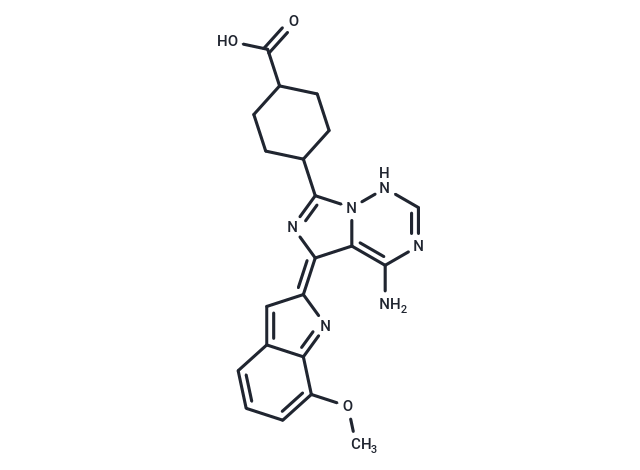Shopping Cart
- Remove All
 Your shopping cart is currently empty
Your shopping cart is currently empty

OSI-027 (ASP4786) is a selective and potent dual inhibitor of mTORC1 and mTORC2 with IC50 of 22 nM and 65 nM, and more than 100-fold selectivity observed for mTOR than PI3Kα, PI3Kβ, PI3Kγ or DNA-PK. Phase 1.

| Pack Size | Price | Availability | Quantity |
|---|---|---|---|
| 1 mg | $35 | In Stock | |
| 2 mg | $48 | In Stock | |
| 5 mg | $78 | In Stock | |
| 10 mg | $141 | In Stock | |
| 25 mg | $261 | In Stock | |
| 50 mg | $409 | In Stock | |
| 100 mg | $596 | In Stock | |
| 1 mL x 10 mM (in DMSO) | $81 | In Stock |
| Description | OSI-027 (ASP4786) is a selective and potent dual inhibitor of mTORC1 and mTORC2 with IC50 of 22 nM and 65 nM, and more than 100-fold selectivity observed for mTOR than PI3Kα, PI3Kβ, PI3Kγ or DNA-PK. Phase 1. |
| Targets&IC50 | mTORC2:65 nM, mTORC1:22 nM |
| In vitro | OSI-027 shows the selective and ATP competitive inhibition activities against mTORC1 and mTORC2 with IC50 of 22 nM and 65 nM, respectively. In addition, OSI-027 inhibits mTOR signaling of phospho-4E-BP1 with an IC50 of 1 μM in cell-based assays. [1] OSI-027 exhibits anti-proliferative activities against several acute leukemia cell lines of myeloid/megakaryocytic origin in a dose-dependent manner, including U937, KG-1, KBM-3B, ML-1, HL-60, and MEG-01 cells. [2] A recent study shows that inhibition of mTORC1/2 by OSI-027 effectively suppresses phosphorylation of Akt (S473) and cell proliferation in breast cancer cells. [3] |
| In vivo | In GEO colorectal xenograft, OSI-027 (65 mg/kg) inhibits both mTORC1 and mTORC2 effectors, including 4E-BP1, Akt, and S6 phosphorylation. Furthermore, mTORC1 and mTORC2 inhibition together by OSI-027 potently inhibits tumor growth more than mTORC1 inhibition by rapamycin. [1] |
| Kinase Assay | Biochemical assays: mTORC1 and mTORC2 inhibition is assayed using native enzyme complex immunoprecipitated from HeLa lysates at 1 mM ATP. To prepare whole cell lysates from HeLa cells, 25 g cell pellet is lysed in 60 mL of ice-cold buffer A [40 mM HEPES (pH 7.5), 120 mM NaCl, 1 mM EDTA, 10 mM sodium pyrophosphate, 10 mM glycerophosphate, 50 mM NaF, 0.5 mM orthovanadate, and EDTA-free protease inhibitors containing 0.3% CHAPS] for 30 minutes on a magnetic stirrer in a cold room. After clearing of the lysates by centrifugation at 13,000 g for 10 minutes, Protein G-coated 384-well plates are incubated with 0.25 μg of mTOR antibody in 15 μL of buffer A for 1 hour at 4 °C. To each well, 40 μg of HeLa cell lysate in 15 μL of buffer A is added and incubated overnight at 4 °C to immunoprecipitate mTOR complexes. Plates are washed 3 times with buffer A and twice with immunoprecipitation wash buffer [Buffer B: 50 mM HEPES (pH 7.5) and 150 mM NaCl]. OSI-027 is added at 10 μM concentration to each well and DMSO is added to the control wells. The reaction is started by adding 150 ng of His-tagged 4E-BP1 as a substrate in the presence or absence of 100 μM ATP to each well in 25 μL of freshly prepared kinase buffer [Buffer C: 20 mM HEPES (pH 7.5), 10 mM MgCl2, 4 mM MnCl2, 10 mM β-mercaptoethanol, and 200 μM vanadate] and incubated at room temperature (RT) for 30 minutes. The reaction is stopped by transferring 25 μL of reaction mixture from each well to corresponding wells of fresh Ni-chelate-coated plates and incubated overnight at 4 °C followed by 2 hours at 37 °C. To detect phosphorylation of 4E-BP1, the plates are washed once with TBST (Tris-buffered saline containing 0.1% Tween-20) containing 5% skim milk powder. To each well, 25 μL of 1:1,000 diluted phospho-4E-BP1 antibodies in TBST containing 5% skim milk are added and incubated for 1 hour at RT.The plates are washed once with TBST and then 25 μL of anti-rabbit HRP (diluted 1:10,000) in TBST containing 5% skim milk is added. The plates are incubated for 1 hour at RT and washed 5 times with TBST. For detection of phospho-4E-BP1, 25 μL of chemiluminescent reagents A+B is added and chemiluminescence is measured using an Analyst plate reader. |
| Cell Research | Inhibition of proliferation is measured using the Cell Titer Glo Assay , as noted in figure legends. To generate dose–response curves, cell lines are seeded at a density of 5,000 cells per well in a 96-well plate. After 24 hours of plating, cells are dosed with varying concentrations of either OSI-027 or rapamycin. The signal for Cell Titer Glo Assay is determined 72 hours after dosing and normalized to that of vehicle-treated controls. Inhibition of proliferation, relative to vehicle-treated controls, is expressed as a fraction of 1 and graphed using PRISM software. (Only for Reference) |
| Alias | OSI027, ASP4786 |
| Molecular Weight | 406.44 |
| Formula | C21H22N6O3 |
| Cas No. | 936890-98-1 |
| Smiles | COc1cccc2=C\C(N=c12)=c1/nc(C2CCC(CC2)C(O)=O)n2NC=NC(N)=c12 |
| Relative Density. | 1.59 g/cm3 |
| Storage | Powder: -20°C for 3 years | In solvent: -80°C for 1 year | Shipping with blue ice. | |||||||||||||||||||||||||
| Solubility Information | DMSO: 15 mg/mL (36.91 mM), Sonication is recommended. H2O: < 1 mg/mL (insoluble or slightly soluble) Ethanol: < 1 mg/mL (insoluble or slightly soluble) | |||||||||||||||||||||||||
Solution Preparation Table | ||||||||||||||||||||||||||
DMSO
| ||||||||||||||||||||||||||

Copyright © 2015-2025 TargetMol Chemicals Inc. All Rights Reserved.